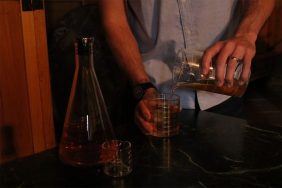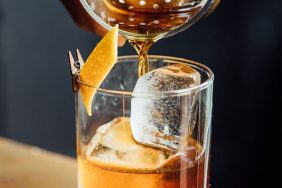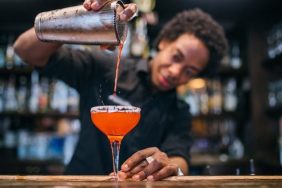
In the last decade, the mixology movement has spread throughout the US, fueled by great bartenders who are creative and willing to take chances on flavors and ingredients that might not be the norm. Trends, like the seasons, are ever changing in the bartending world. From the return of the Pickleback to the use of bitter liqueur, unique and sometimes strange flavors are the name of the game for many bartenders.
If you have a strong background on the building blocks of classic cocktails, you can begin trying new, creative things. “You will find through trial and error that you can’t just remove and replace ingredients,” says Bartending Consultant Willy Shine. “Once you understand how flavors work together, you can then start using different ingredients.”
Related: Trip Out With The Creators Of The McNuggetini
The only way to accomplish this is through years of tasting ingredients individually and then ultimately through learning how the flavors all work together. The more a bartender learns, the more they begin to realize that there is always an easier and simpler way to reach a flavor profile without using too many ingredients. “We will never stop learning and this is one of the beauties of our craft.”
Here’s a look at some of the unique ingredients and bartending trends from across the US.
Cynar Cocktails

Cynar is an Italian bitter liqueur classified as an amaro. It’s a blend of distilled herbs and plants with an extremely surprising main ingredient: artichokes. “Since Cynar has both bitterness and sweetness you don’t necessarily need to use bittering agents (such as bitters) or sweetening agents (such as simple syrup) to make a balanced cocktail,” says Jason Wagner, Beverage Director of New York’s Fung Tu.
Wagner makes a Manhattan with Cynar instead of the usual vermouth. “It adds a layer of bitter complexity.” He finds that Cynar works best with dark spirits. “Try substituting Cynar for certain ingredients in your favorite classic cocktails for a new twist on something you already like.”
Mayur Subbarao, Beverage Director at New York’s Louro likes to use Cynar because of its bold flavor. “It has a relatively high acid level for an amaro as well as a rich bitter chocolate undertone,” says Subbarao. “Because of its acidity level and proof, Cynar can actually substitute in a cocktail either for a liqueur or a vermouth, which is fun when deciding on cocktail variants.”
Brandy Cocktails

Depending on the Brandy that you use you can change the texture and flavor of the drink. An oak aged Brandy, such as Cognac, can bring a hint of vanilla flavor to the drink. “I like to use Brandy in our take on the classic cocktail French 75,” says Wagner. Some bartenders argue the original recipe even used Cognac. “I find that Cognac in that drink brings a depth of flavor and complexity you don’t find when Gin is used.” Part of what makes brandy a good choice in many classic cocktails is because it can be less sweet than bourbon. “Try using that for Bourbon cocktails you find too sweet.”
Brandy is an extremely diverse category incorporating everything from extremely bright, funky eaux-de-vie to rich caramel flavors. “With respect to the traditional French brandies (cognac-Armagnac-calvados), I find that they lend a measure of softness and elegance to drinks, especially stirred cocktails,” says Subbarao.
Subbarao uses American apple brandy in drinks that are based around a whiskey-like profile. He does this because the heavy, oak characteristics of brandy are great alternative to whiskey. “I love combining many aged brandies with something funky, like an Islay malt whisky or a rum with strong hogo [musky] characteristics.”
Fat-Washed Cocktails

Fat-washing isn’t very different than infusing a spirit. “You go through a process to fuse the flavors of the bacon fat to the alcohol, very similarly to infusing something like vanilla bean,” says Shine. The difference lies in the process of how exactly you infuse the flavor.
“In fat-washing, you combine 1oz. of the bacon fat and 25 oz. of spirit and freeze it.” During the freezing process, the flavors from the bacon fat infuse with the spirit. “You must put the liquid through cheesecloth a few times to remove any particles that may have been left behind,” says Shine.
Recently, Shine used this process to infuse some smoky flavors into Appleton Estate Rum. “I chose apple smoked bacon, maple syrup and All Spice because all of the flavors either work really well together or come from Jamaican cooking.”
Shine was first introduced to fat-washing by his friend and colleague, Don Lee when he was bartending at New York’s PDT (Please Don’t Tell). “He created the Benton’s Old Fashioned, which was a bacon fat-washed bourbon old fashioned.”
There are many benefits of using fat-washed spirits in cocktails. The main benefit is the addition of another layer of creativity in order to invent or create new, unique flavors that work well together. “The Old Fashioned is a classic cocktail recipe which I riffed off– typically the recipe would call for Rye or Bourbon, but I used a Jamaican Rum that has been aged in Bourbon barrels,” says Shine. “I then deconstructed and incorporated flavors of the rum – like maple, chocolate, orange peel, and All Spice – with flavors born from the Jamaican culture itself.”
Usually fat-washing is stirred style of cocktail. “However, when I was in Spain with AKA Wine Geek years ago, we created a Jamon fat-washed gin that we used in a Red Snapper- a gin variation on a Bloody Mary. That was pretty rad,” says Shine.
Pickleback Cocktails

Thought to have originated from Brooklyn hipster bars, the Pickleback is a two shot drink. The first shot is whiskey and it is followed directly after with a shot of pickle juice. It sounds like it would be a sour, terrifying experience, but the flavors actually work really well together. There’s no limit to the amount of Pickleback variations that have begun to spring up around the world. Bartenders have begun using pickled olive juice, radish and myriad other flavors. If you can pickle it, they are using it for Picklebacks.
Photos: Getty.








